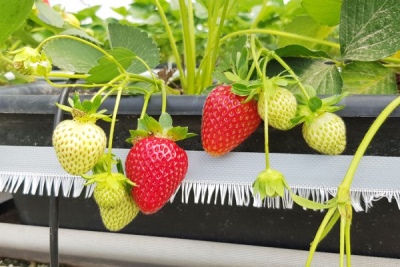
- Authors: University of Florida (USA) in collaboration with the Queensland Department of Agriculture and Fisheries (Australia)
- Name synonyms: Florida Beauty
- Taste: pleasant dessert
- The size: average
- Weight: 19-22 g
- Yield rate: high
- Repairability: Yes
- Ripening terms: early
- Advantages: excellent resistance to rain
- Appointment: universal
Florida Beauty strawberry is one of the newest varieties of American selection. Despite the fact that it went on sale recently, many gardeners have noted its excellent taste, good yield and endurance.
Breeding history of the variety
The Florida Beauty strawberry variety (a synonym for the name in English Florida Beauty) was developed in the United States at the University of Florida in collaboration with the Queensland Department of Agriculture and Fisheries (Australia). During 2015-2016, Florida Beauty was successfully tested in the central and western regions of the state of the same name. As a result, the variety was patented and began to gain popularity in various regions of America and Europe.
Description of the variety
This strawberry variety is characterized by its remontability. This concept means the genetic ability to bear fruit several times per season. The Florida Beauty bush is compact and open, semi-spreading. It is of medium height, with rounded dark green leaves. The variety is capable of producing a lot of mustache.
Florida Beauty blooms in the last days of May. Peduncles are tall with an abundance of inflorescences. The diameter of the flower corolla is 2.3 cm. The plant can have both flowers and ripe fruits at the same time.
Ripening terms
Strawberries of this variety are characterized by early fruiting times. The berries ripen at the end of June. Mass ripening of the first wave ends in mid-July. Since this is a remontant variety, the next harvest ripens at the end of August.
Yield
Florida Beauty is a high-yielding variety. It is possible to collect about 1-1.5 kg of strawberries from one plant. In central Russia, you can harvest fruits 2 times per season, in warmer southern regions or in a greenhouse - 3 times.
Berries and their taste
The variety is characterized by large berries of bright red color, the average weight of one specimen is 19-22 g. The conical fruits of Florida Beauty are evenly colored. They are the same in size in the first and second wave of fruiting, ripening begins at the tip. The skin of the fruit has an attractive shine, glows beautifully in the sun.
Florida Beauty strawberry is characterized by a pleasant rich dessert taste and high sugar content in fruits. The pulp is juicy, very dense and firm. The berries have a pronounced strawberry aroma. They are universal in use, they can be used both fresh and in various preparations for the winter. The variety is easy to transport, fruits are stored in the refrigerator or in cool rooms for about a week.
Growing features
Florida Beauty is an easy-to-grow variety. It can be cultivated both outdoors and in a greenhouse. It is frost-hardy and has good immunity to disease, Florida Beauty berries tolerate rain well. An adult bush should be watered 2 times a week using drip irrigation, especially during the formation of fruits. It is better to mulch the soil near the plants.




Site selection and soil preparation
The planting site for the variety should be on a small, well-lit hill, never in a lowland. It is recommended to plant Florida Beauty in the spring after warming the soil or in the fall at least a month before the first frost. For planting in the spring, the soil is prepared in the fall, for the fall - at least 14-15 days in advance. The earth must be dug up and humus (a bucket per 1 m2) and wood ash (250-300 g per 1 m2) must be added. The soil should be neutral or slightly acidic.

Pollination
Like all modern varieties of remontant strawberries, Florida Beauty has bisexual flowers. This means that the plant is self-pollinating. No additional pollination is required for further fruit setting.

One of the important techniques in strawberry care is feeding. Regular fertilization guarantees a rich harvest. There are several different ways to feed strawberries, and each of them is designed for a specific period of plant development. During flowering, fruiting and after it, feeding should be different.

Diseases and pests
This variety has good immunity, relatively resistant to root rot, but susceptible to powdery mildew. Therefore, in order to prevent it, it is recommended to treat the bushes with "Fitosporin". From weevils, plants should be treated with Fitoverm 2 times, observing an interval of 5 days.

Strawberries are often subject to many dangerous diseases that can seriously undermine their condition. Among the most common are powdery mildew, gray mold, brown spot, anthracnose, and verticillosis. Before buying a variety, you need to inquire about its disease resistance.
Reproduction
In order to propagate the Florida Beauty variety, the mustache of strong healthy bushes is placed in grooves made in the ground. The first 2 sockets should be left, and the remaining shoots should be removed. When 3 full leaves appear on the rooted plant, the mustache is cut off. After a week, young bushes can be transplanted to a permanent place.



















































































